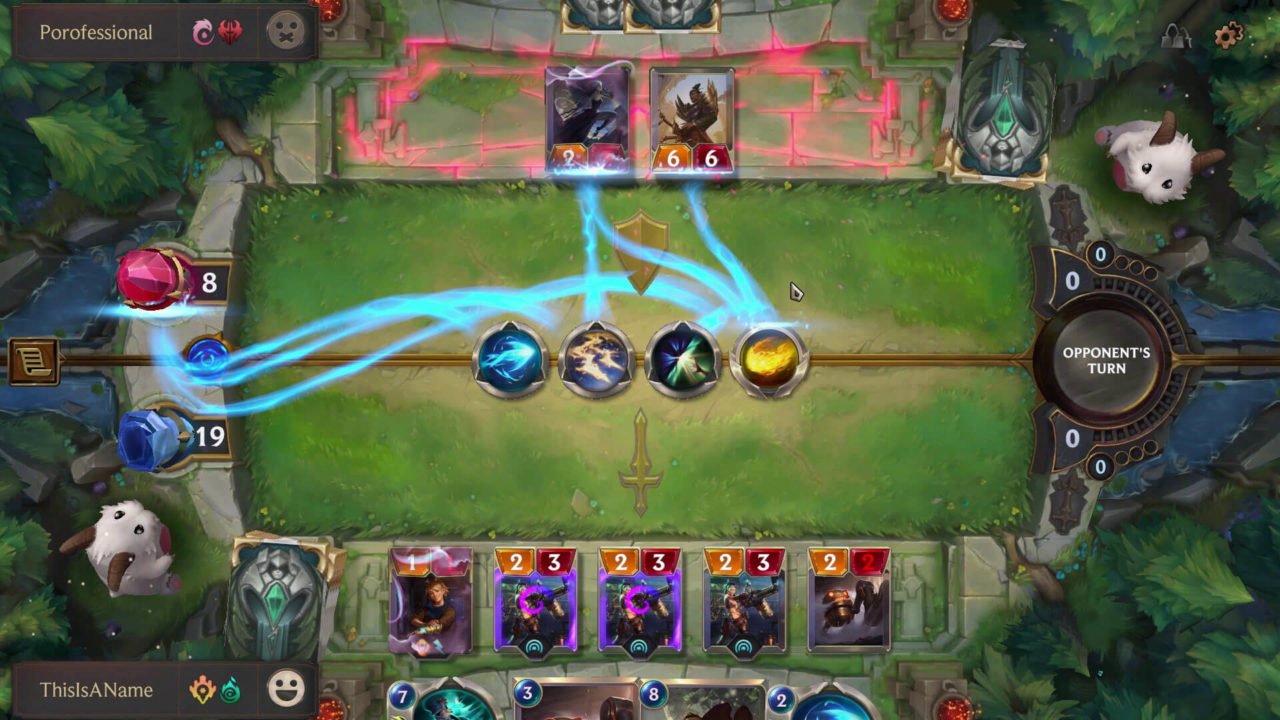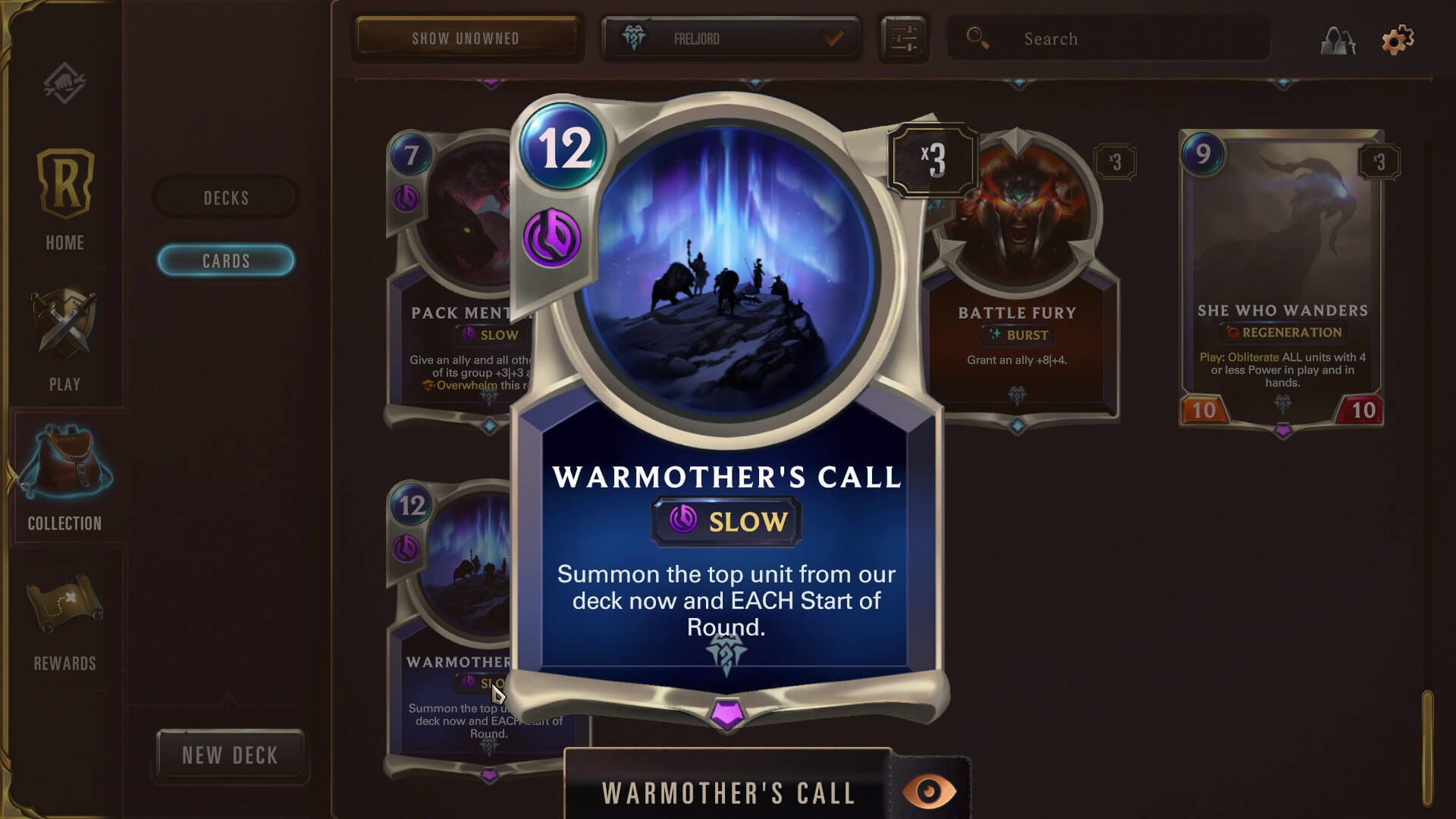Legends of Runeterra How to Play & FAQ
What is Legends of Runeterra?
Set in the world of League of Legends, Legends of Runeterra is the strategy card game where skill, creativity, and cleverness determine your success.
In LoR, you can:
Build decks with your favorite League champions (and new characters) from the regions of Runeterra, each with their own style and strategic advantage. Face off in dynamic, alternating combat full of opportunities for outplay.
Earn cards for free as you play or buy exactly what you want in the store—you’re in control of your collection.
But that’s just the beginning check out this video for an in-depth look.
There are 318 cards in the initial set and they’re divided into six regions
Those regions are Demacia, Freljord, Ionia, Noxus, Piltover & Zaun and Shadow Isles. You can see where they are relative to one another in this interactive map of Runeterra.
There are 24 League of Legends champions in the initial set of cards
They are, by region:
– Demacia: Lucian, Fiora, Lux and Garen
– Freljord: Braum, Ashe, Anivia and Tryndamere
– Ionia: Zed, Shen, Yasuo and Karma
– Noxus: Draven, Katarina, Vladimir and Darius
– Piltover & Zaun: Teemo, Ezreal, Jinx and Heimerdinger
– Shadow Isles: Elise, Kalista, Thresh and Hecarim
Legends of Runeterra won’t have card packs
Getting random cards can be fun, but sinking a heap of money into card packs and not getting anything you want to use can be pretty demoralising. Legends of Runeterra is keeping the former while eliminating the latter. Any cards that players get randomly will be cards they unlock through playing the game. Instead of buying packs with real-world money, players will instead buy coins (one of two in-game currencies), which can then be spent on wildcards, which can be swapped for whatever card they want of the corresponding rarity. Wildcards will come in four tiers – common, rare, epic and champion, from cheapest to most expensive.
You can buy the cards you want… but there’s a limit
The in-game store will only stock so many wildcards each week, so there’s an actual limit to how many cards you can buy at a time. Why? The team doesn’t want people to be able to instantly buy their way into a complete collection. Part of the fun of card games is finding a way with the collection you do have, as opposed to just blindly copying whatever the top meta deck is. The idea is that the player base as a whole will be restricted, so everyone will be steadily their collection.
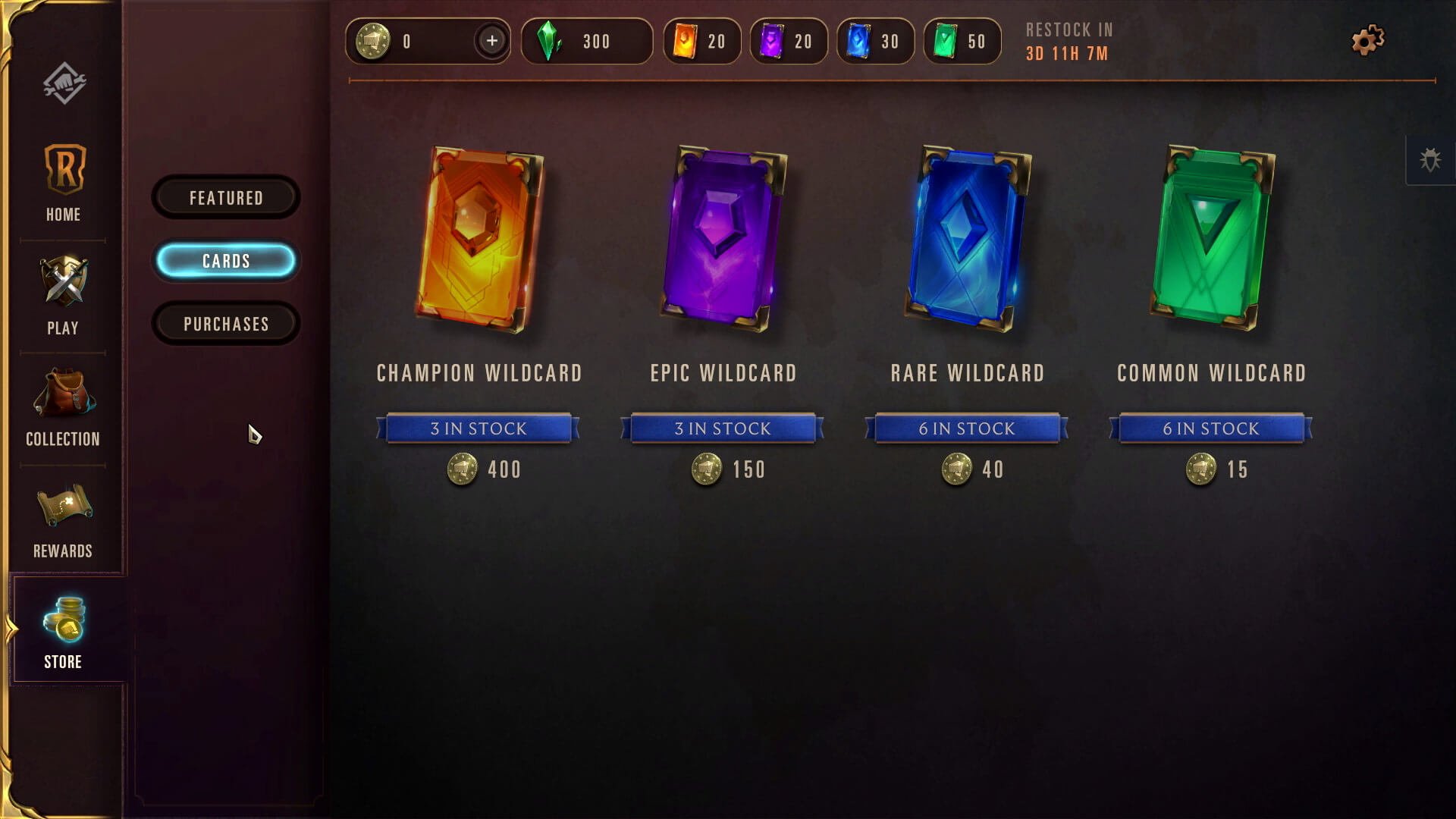
Cards can also be purchased with Shards
In addition to wildcards (which are earned through in-game rewards or purchased with coins), players can also buy cards using Legends of Runeterra’s other currency – Shards. Shards are earned through region roads and the weekly vault (more on those in a sec), plus, they’re also given to you in place of a fourth copy of a card in random rewards, as the deck limit is three. In that instance, you’ll get around 17% of the Shard purchase value for commons, with the percentage rising with card rarity, capping off at around 25% for champions.
There’ll be plenty of other ways to expand your collection
Legends of Runeterra will have daily quests, a weekly vault and the ability to choose a region (akin to colours in Magic or classes in Hearthstone) to focus on. Playing the game and completing daily quests will reward you with XP, which funnels into the other two systems.
Every week will have a “vault day”
The weekly vault is exactly what it sounds like – a vault that levels up the more you play, and then unlocks for every player on the same day. How does it level up? The chests inside upgrade, increasing the number of cards you’ll receive in each. Plus, both the cards and chests have a chance to upgrade further. If you hit level ten you’ll also be guaranteed a champion.
For committed players it will represent a decent card injection every week (“basically just cards raining down on you,” Design Director Andrew Yip told me), and the team wants “vault day” to be something the entire community looks forward to each week.
You can also pick the region you want to focus on
There’s nothing worse in a CCG than opening packs – or being awarded cards – only for none of them to be relevant to the class or archetype you want to play. Legends of Runeterra addresses this by allowing players to pick a region to funnel your XP into.
If you think Shadow Isles has the play style or champion for you, then select it on the Rewards screen, and you’ll unlock a steady stream of rewards devoted to that class. These can be everything from individual cards and wildcards of defined rarities through to chests and capsules with multiple rewards. And if you decide you want to focus on another region, just swap.
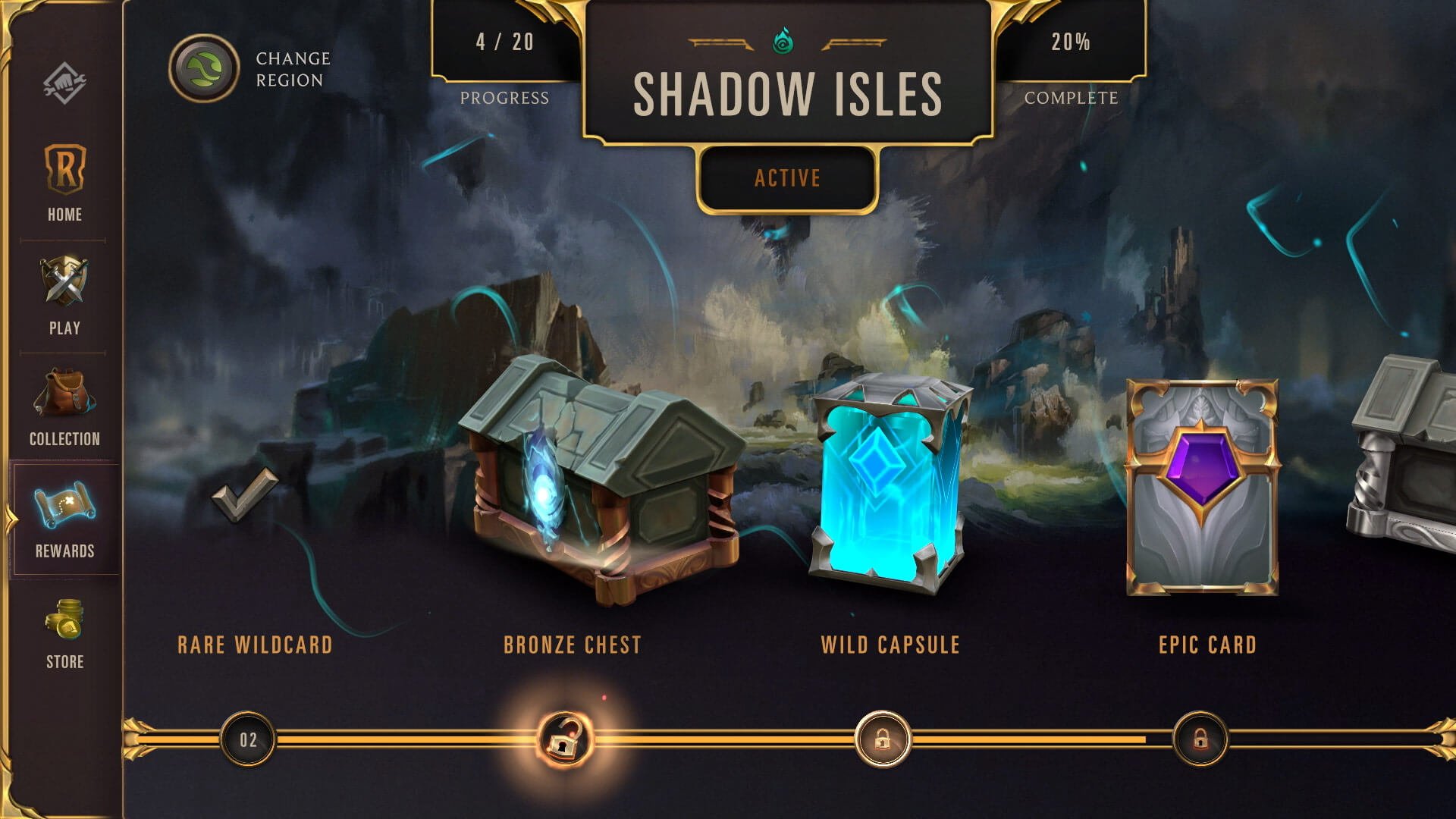
Each region has a very distinct identity
Noxus cards, for instance, are all about aggression and closing out games. Their units typically have more attack than health, and may be overstatted for their cost, but with downsides like an inability to block. Many of them are focused on dealing damage to the opposing Nexus (i.e. opponent) or buffing their allies. Each region is also really different in terms of the world they live in, and what kind of characters they are. Noxus cards, for instance, feature a lot of impossibly brawny or heavily armoured men fighting it out in arenas reminiscent of Ancient Rome. Also, Wolverine.
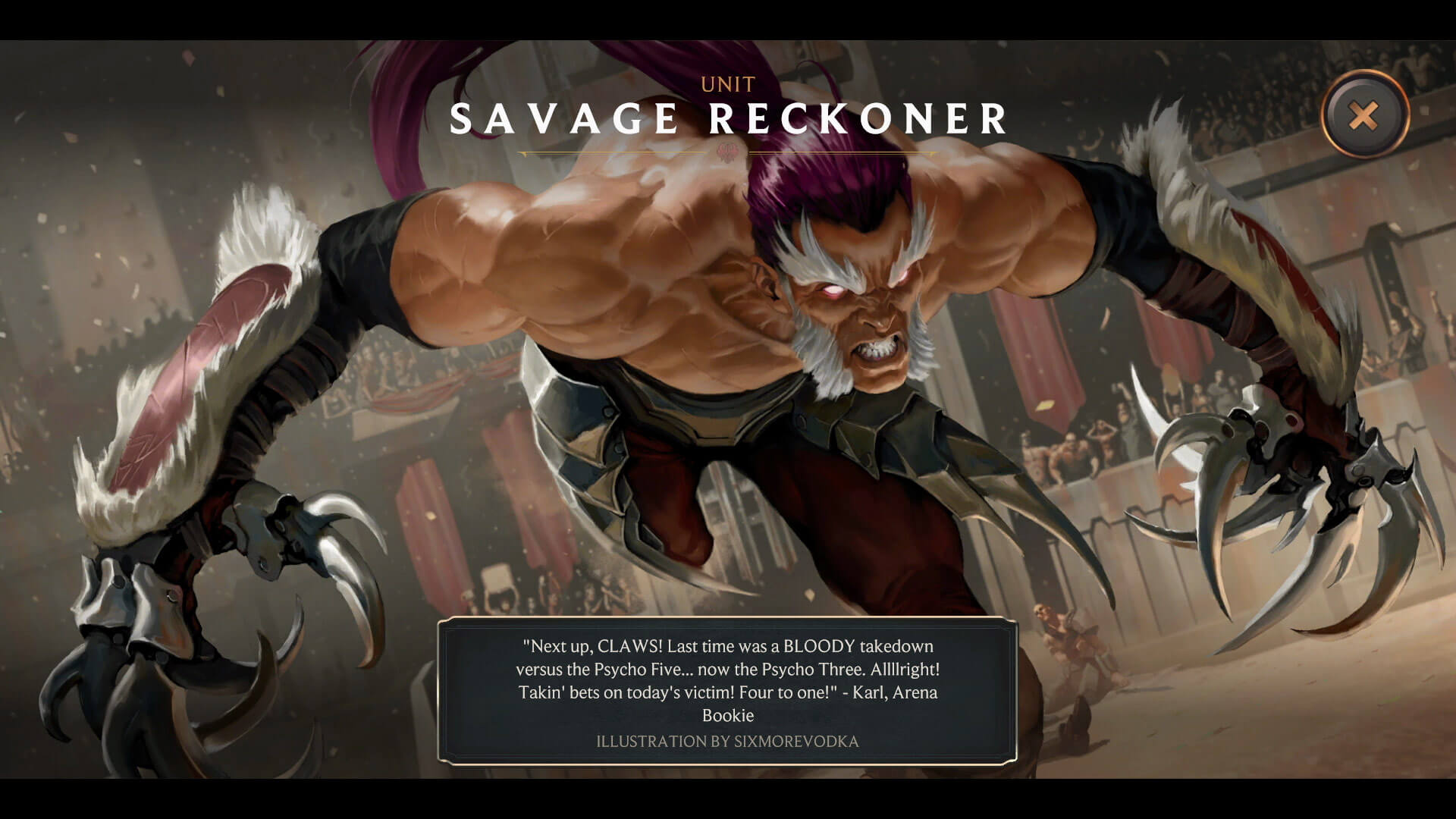
Decks can be built using cards from two regions
That means there are 21 possible combinations of regions. Using the example of Noxus again, you can look to find a region that shores up its weaknesses, or perhaps one that doubles down on its strengths. Many regions already have some obvious in-built synergies, so you may notice when browsing Noxus’ cards, for instance, that there are quite a few spiders in the mix, which would naturally get you thinking about how Noxus may work with Shadow Isles, given one of the themes of that region (and Elise specifically) is utilising spiders.
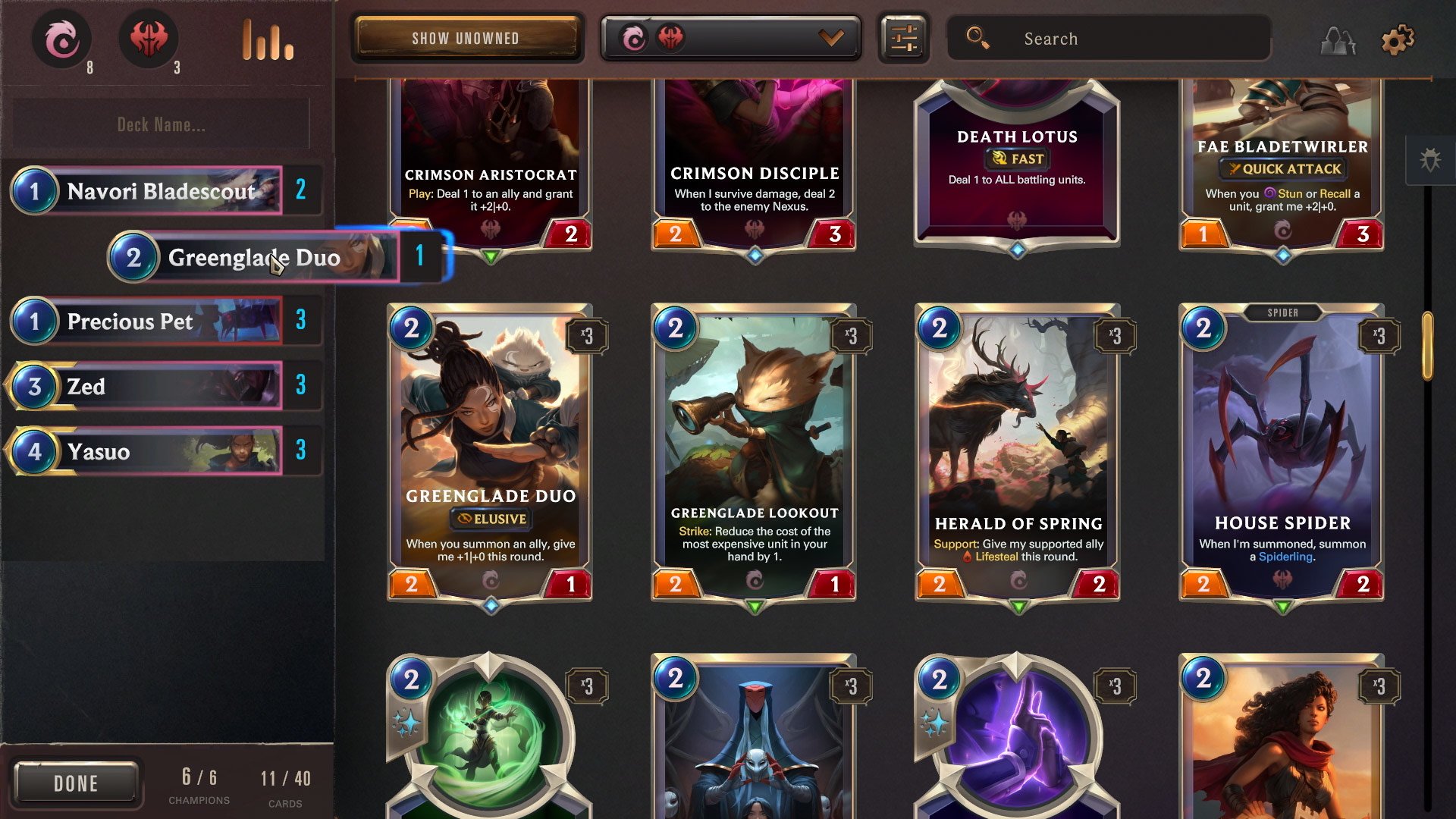
There are no neutral cards
Every single card in Legends of Runeterra is allied with a specific region, so unlike many other CCGs there are no neutral cards. The team said that they toyed with them for a while, but ultimately it meant you’d see the same cards too often.
There are no dual region cards but there is limited mono support
The Legends of Runeterra team are really focused on the idea that any one card can go in a deck with any other one card, so there are no dual region cards in the initial set. There is, however, support for single region archetypes in the form of cards with “Allegiance”, which activates if the top card of the player’s deck is of the same region as the card with Allegiance. There’s one unit with Allegiance per region.
Any champion can team up with any other champion
The upshot of the two region system is that you can come up with some wild combinations, not only of regions – and thus gameplay mechanics – but of champions too. If there are two champions that you’d really love to see fighting side by side, you can try and make it work.
Each champion can level up during a game
This is done by completing a mini quest specific to that champion. A basic example would be Garen, who simply has to attack twice to level up. His level two form is slightly bigger, but can also attack every round, regardless of whether the player is attacking or defending (more on that shortly).
Each champion has a unique perk when levelled up – some being more complicated than others, but they all typically play into their strategy. Elise, for instance, is all about summoning spiders, so it makes sense when she becomes Spider Queen Elise for those units to get powerful new keywords.
Once a champion levels up, all your other copies also level up
In the example above, if you have three copies of Elise in your deck, and you level up the first copy you draw, the other two copies will also be levelled up versions if you draw into them.
You can have three copies of a champion in your deck
This is the same limit for every other card, but with a twist – you can only have six champion cards in your deck in total. So that means you can have two champions with three copies each, or you could decide to have three champions with two of each, and so on. Decks are 40 cards in total.
There can be only one copy of a champion in play
If you have two copies of, say, Shen in hand, and you play one, while he’s on the board, the other copy turns into “Shen’s Stand United” – a modified version of an Ionian spell that can help you level him up. If you play it, it will then shuffle a Shen back into your deck. If you don’t play it and the Shen in play dies, the spell will turn back into the champion card. Each champion is associated with a specific spell from their region.
Each round, one person attacks and the other defends
If you’re attacking, you’re able to play units and choose to attack with them on the same turn, so there’s no summoning sickness in Legends of Runeterra. If you’re defending, you’re also able to play units, then choose how to block when your opponent initiates their attack. (As a side note, there are certain champions, like Garen and Katarina that can still attack on rounds when a player is defending, but they both need to be levelled up to do so.)
Each round is designed to be a back and forth
After every action that the attacker takes, the defender has a chance to respond. If an attacker plays a unit, the defender then has an action of their own, in which they can also play a unit if they choose, or they can cast a spell, or they can simply choose to pass.
The fact that the potential to take action can be passed back and forth many times in a single round opens up a huge amount of strategy, from simple things, like buffing a unit out of range of an attack or outright recalling it to hand, through to more subtle strategies like holding back mana until the end of a round to surprise your opponent.
It’s also really compelling seeing how one spell can be used to counter another and so on, building up a big chain that then gets resolved when both players have exhausted their options. In Legends of Runeterra you’re constantly being called on to make decisions both small and large, and it makes for a deep gameplay experience once you start getting your head around it.
Attacks are resolved sequentially from left to right
In other words, when you set your minions to attack the enemy Nexus, they do so, one after the other, from left to right. This means that you can tee up buffs or level ups that happen mid-way through combat. A simple example would be Darius, whose level up condition is “The enemy Nexus has 10 or less health.” If you place him to the right of units that are going to take the enemy Nexus below 10, instead of having a six attack Darius when it’s his turn to hit, you’ll have a ten attack Darius. Incidentally, you can have six units in play at the most. (And ten cards in hand.)
Up to three points of mana can be banked as “spell mana”
If you have nothing to do on round three, it may not be a complete disaster, as passing the turn will see those three points of unspent mana automatically pushed across to be stored as spell mana. As the name suggests, this mana can only be spent on spells, so it’s unlikely to be used to gain you tempo, but it can certainly be a valuable resource with which to respond to what your opponent is doing.
Only three mana total can be banked as spell mana, but it can also be used in conjunction with your “main” mana to play spells that cost more than your current mana total. The Freljord spell “Warmother’s Call”, for instance, can ONLY be played by utilising spell mana.
Every spell has one of three spell-centric keywords
Spells in Legends of Runeterra fall into three categories – Slow, Fast and Burst. Slow spells are cast like a playing a unit – they take up an action, and your opponent gets a chance to respond before it plays out. Fast spells can be cast in the same way, but can also be used to respond to Fast or Slow spells. Casting a Fast spell also gives your opponent the chance to respond. Burst spells, on the other hand, resolve instantly, with no opportunity for a response, and don’t take up your action, allowing you to also do something else.
